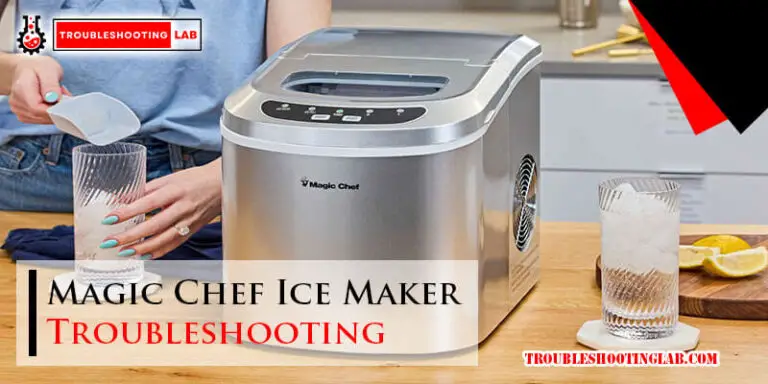Ge Profile Refrigerator Troubleshooting: Quick and Easy Fixes
For Ge Profile Refrigerator troubleshooting, check the power supply and temperature settings first. Ensure the door seals are intact and clean.A Ge Profile Refrigerator is a reliable appliance, but like any machine, it can encounter issues. Common problems include the refrigerator not cooling, unusual noises, or water leakage. Addressing these issues promptly can prevent further damage and ensure the appliance runs efficiently.
Regular maintenance, such as cleaning the coils and checking the door seals, can also help. Understanding the basics of troubleshooting can save you time and potentially costly repairs. This guide will help you identify and resolve common problems with your Ge Profile Refrigerator, ensuring it remains in optimal working condition.
Common Issues
Many users face common issues with their GE Profile refrigerators. These issues can disrupt daily life. Knowing how to fix them can save you time and money.
Temperature issues are common in GE Profile refrigerators. The fridge might be too warm or too cold. This can spoil your food.
- Check the temperature settings. Ensure they are set correctly.
- Inspect the door seals. Make sure they are clean and tight.
- Look for any blockages in the vents. Clear them if needed.
- Verify the condenser coils. Clean them if they are dirty.
Strange noises can be alarming. These sounds often mean there is a problem. Here are some common causes:
| Noise Type | Possible Cause | Solution |
|---|---|---|
| Banging | Loose parts | Tighten any loose components |
| Buzzing | Compressor issue | Check the compressor for faults |
| Clicking | Defrost timer | Inspect and replace if necessary |
| Humming | Fan motor | Clean or replace the fan motor |
Identifying these issues early can prevent bigger problems. Regular maintenance is key. Keep your refrigerator in top shape.

Temperature Problems
Temperature problems can spoil food and cause frustration. It’s vital to maintain the right settings in your GE Profile refrigerator. Below, we break down common temperature issues and offer solutions.
Refrigerator Too Warm
If your refrigerator is too warm, check these factors:
- Thermostat Settings: Ensure the thermostat is set to the right temperature. The ideal setting is 37°F (3°C).
- Blocked Vents: Make sure air vents are not blocked by food items.
- Door Seals: Check if the door seals are tight. Replace if needed.
Use a thermometer to confirm the internal temperature. Adjust settings accordingly.
Freezer Too Cold
An overly cold freezer can cause issues too. Follow these tips to fix it:
- Temperature Settings: Set the freezer temperature to 0°F (-18°C).
- Frost Buildup: Check for frost buildup. Defrost if necessary.
- Fan Operation: Ensure the internal fan is working properly.
Regularly clean the freezer to prevent frost accumulation.
| Issue | Possible Cause | Solution |
|---|---|---|
| Refrigerator Too Warm | Wrong thermostat setting | Set thermostat to 37°F (3°C) |
| Refrigerator Too Warm | Blocked air vents | Clear vents |
| Freezer Too Cold | Incorrect temperature setting | Set to 0°F (-18°C) |
| Freezer Too Cold | Frost buildup | Defrost freezer |
Strange Noises
Strange noises from your GE Profile refrigerator can be worrisome. These sounds often indicate minor issues that you can fix. Understanding these noises helps you maintain your appliance better.
Humming Sounds
A constant humming noise is usually normal. It often comes from the compressor or fans. This sound indicates that your refrigerator is working to cool down.
If the humming becomes too loud, it might be a sign of a problem. Check if the refrigerator is level. Uneven surfaces can make the compressor work harder.
To level your refrigerator, adjust the leveling legs. Use a spirit level to ensure it is even.
Note: If the humming persists, it might need professional attention.
Rattling Noises
Rattling noises often come from loose parts or items inside. First, check if anything inside the refrigerator is causing the noise.
- Ensure that bottles and jars are not touching each other.
- Secure any loose parts like shelves or bins.
If the rattling continues, the issue might be external. Check the back of the refrigerator. Ensure that it is not too close to the wall.
Also, inspect the drip pan. A loose drip pan can cause rattling sounds.
Tip: Tighten any loose screws or bolts you find.
| Noise Type | Possible Cause | Solution |
|---|---|---|
| Humming | Compressor or fans | Level the refrigerator |
| Rattling | Loose parts or items | Secure loose items and parts |
Address these noises promptly to ensure your refrigerator runs smoothly. Regular maintenance can prevent these issues from recurring.
Water Dispenser Issues
The water dispenser is a key feature of the GE Profile Refrigerator. It provides easy access to clean, cold water. But sometimes, it may face issues. This guide will help you troubleshoot common problems like no water flow or slow water flow.
No Water Flow
If your water dispenser has no water flow, follow these steps:
- Check if the water supply is turned on.
- Inspect the water line for any kinks or bends.
- Ensure the water filter is correctly installed.
- Replace the water filter if it’s clogged.
If the problem persists, the water inlet valve may be faulty. Consider contacting a professional for further inspection.
Slow Water Flow
A slow water flow can be frustrating. Here are some steps to fix it:
- Check if the water filter needs replacement.
- Inspect the water pressure from your main supply.
- Look for any kinks in the water line.
If these steps do not solve the issue, the water valve might be partially blocked. A professional technician can help.
By following these steps, you can resolve most common water dispenser issues in your GE Profile Refrigerator.
Ice Maker Malfunctions
The ice maker is a crucial feature in your GE Profile refrigerator. When it malfunctions, it can be frustrating. This section will help you troubleshoot common ice maker issues. Let’s dive into the most frequent problems: no ice production and a stuck ice dispenser.
No Ice Production
Is your ice maker not producing ice? Follow these steps to troubleshoot:
- Check the Water Supply: Ensure the water line is connected properly.
- Inspect the Filter: A clogged filter can stop ice production. Replace it if needed.
- Temperature Settings: Make sure the freezer is cold enough, ideally at 0°F.
- Ice Maker Switch: Verify the ice maker is turned on. The switch should be in the “on” position.
- Reset the Ice Maker: Try resetting the ice maker. Locate the reset button and hold it for 10 seconds.
Ice Dispenser Stuck
Is your ice dispenser not working? Here are some tips to fix it:
- Check for Ice Blockage: Sometimes ice chunks get stuck. Remove any visible blockages.
- Inspect the Auger Motor: The auger motor might be jammed. Listen for any unusual noises.
- Test the Dispenser Switch: The switch may be faulty. Test it by pressing the lever and listening for a click.
- Clean the Dispenser Area: Dirt and grime can cause issues. Clean the dispenser thoroughly.
- Reset the Refrigerator: Unplug the refrigerator for a few minutes. Plug it back in and test the dispenser.
Door Seal Problems
Door Seal Problems in a GE Profile Refrigerator can cause various issues. A faulty door seal can lead to energy inefficiency and food spoilage. Understanding these problems helps in maintaining your refrigerator’s performance.
Loose Door Seal
A loose door seal can compromise the refrigerator’s cooling efficiency. Check for gaps between the door and the main body of the refrigerator.
- Inspect the door seal for any visible damage.
- Clean the seal with warm, soapy water.
- Dry the seal thoroughly before checking its fit.
If the door seal remains loose, it might need replacement. A tight seal keeps the cold air inside and helps the refrigerator work efficiently.
Condensation On Seal
Condensation on the door seal is a common issue. It can result from a humid environment or a faulty seal. Moisture buildup can lead to mold and mildew.
- Check the humidity levels in your kitchen.
- Wipe down the door seal regularly to remove moisture.
- Ensure the refrigerator door closes properly.
If condensation persists, inspect the seal for cracks or tears. Replace it if necessary to prevent further moisture problems.
Maintaining a proper door seal is crucial for your refrigerator’s efficiency. Regular checks and cleaning can prevent most issues.
Display Panel Errors
Encountering issues with your GE Profile refrigerator’s display panel can be frustrating. These panels are crucial for monitoring and controlling your fridge’s settings. Understanding and resolving these errors can save you time and money. Let’s dive into the common display panel errors and how to troubleshoot them.
Error Codes
Your GE Profile refrigerator may display error codes to indicate specific problems. Recognizing these codes is the first step in troubleshooting. Here are some common error codes:
- FF: Freezer temperature is too high.
- CC: Refrigerator temperature is too high.
- PF: Power failure detected.
- CI: Ice maker not functioning properly.
To resolve these error codes, follow these steps:
- Check the manual for specific instructions.
- Ensure proper ventilation around the fridge.
- Reset the refrigerator by unplugging it for 30 seconds.
- Contact a professional if the error persists.
Unresponsive Panel
An unresponsive panel can be a sign of a deeper issue. Here are some potential causes and solutions:
| Cause | Solution |
|---|---|
| Power Issues | Check if the fridge is properly plugged in. |
| Control Lock | Ensure the control lock feature is not activated. |
| Software Glitches | Perform a reset by unplugging the fridge for 30 seconds. |
| Hardware Faults | Contact a technician for a thorough inspection. |
If your panel remains unresponsive, consider contacting GE customer support. They can provide further assistance and, if necessary, arrange for professional repair services.
Maintenance Tips
Proper maintenance of your GE Profile Refrigerator ensures it runs efficiently. Regular upkeep prevents unexpected breakdowns and extends its lifespan. Here are some essential maintenance tips.
Regular Cleaning
Regular cleaning keeps your refrigerator hygienic and efficient. Follow these steps for a thorough cleaning:
- Weekly Wipe Down: Wipe the exterior with a damp cloth. Clean spills immediately.
- Monthly Interior Cleaning: Remove all items. Use a mixture of warm water and baking soda to clean shelves and drawers.
- Clean the Gasket: The door gasket can collect dirt. Clean it with warm soapy water to ensure a tight seal.
- Defrost the Freezer: If you notice frost buildup, defrost the freezer. This keeps it running efficiently.
| Cleaning Task | Frequency |
|---|---|
| Exterior Wipe Down | Weekly |
| Interior Cleaning | Monthly |
| Gasket Cleaning | Monthly |
| Freezer Defrosting | As needed |
Filter Replacement
Replacing filters regularly is crucial for clean air and water. Here’s how to manage it:
- Locate the Filter: Check your user manual for the filter location.
- Turn Off the Water Supply: Before replacing, turn off the water supply.
- Remove the Old Filter: Twist the old filter counterclockwise to remove it.
- Install the New Filter: Insert the new filter and twist it clockwise to secure.
- Turn On the Water Supply: Once the new filter is in place, turn the water supply back on.
Filter Life: Replace water filters every six months. Air filters should be checked every three months. Replace as needed.
| Filter Type | Replacement Frequency |
|---|---|
| Water Filter | Every 6 months |
| Air Filter | Every 3 months |
Regular maintenance keeps your GE Profile Refrigerator running smoothly. Follow these tips for optimal performance.
Frequently Asked Questions
What Is The Most Common Problem With Ge Profile Refrigerators?
The most common problem with GE Profile refrigerators is temperature inconsistency. Users often report fluctuating temperatures, affecting food preservation.
How Do I Reset My Ge Profile Refrigerator?
To reset your GE Profile refrigerator, unplug it for 30 seconds. Plug it back in. This should reset the system.
How Do I Run Diagnostics On My Ge Profile Refrigerator?
To run diagnostics on your GE Profile refrigerator, press and hold the “Energy Saver” and “Lighting” buttons for 8 seconds. Use the temperature control buttons to navigate and select diagnostic tests.
Why Is My Ge Profile Not Cooling?
Your GE Profile may not be cooling due to dirty condenser coils, faulty fans, or a malfunctioning thermostat. Check for blockages and ensure proper airflow. Consult the user manual for troubleshooting steps. If issues persist, contact a professional technician for assistance.
Why Is My Ge Profile Refrigerator Not Cooling?
Check if the thermostat is set correctly. Clean the condenser coils. Ensure the vents are not blocked.
Conclusion
Troubleshooting your GE Profile refrigerator doesn’t have to be daunting. Follow our guide for quick and effective solutions. Regular maintenance can prevent many issues. Always consult your user manual for specific instructions. Address problems early to ensure your fridge runs smoothly for years.
Enjoy fresh food and peace of mind with a well-functioning appliance.






